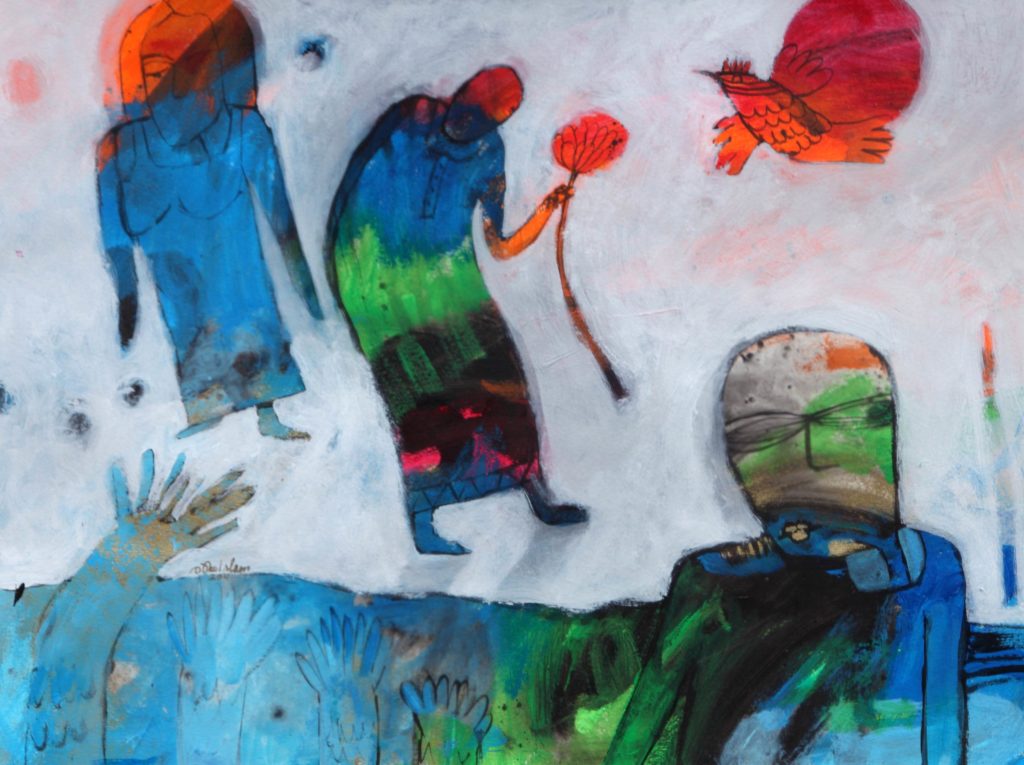Courtesy of the Hindiyeh Museum of Art
 ISLAM KAMIL ALI
ISLAM KAMIL ALI
UNTITLED (2011)
47 x 62 CM, ACRYLIC ON CANVAS
Courtesy of the Hindiyeh Museum of Art
 ISLAM KAMIL ALI
ISLAM KAMIL ALI
UNTITLED (2011)
47 x 62 CM, ACRYLIC ON CANVAS
Translated by ROBIN MOGER
Not many of us knew Sharif. He had been gone from the village for more than thirty years, and the few times his name came up, the person in question would glance around and lower their voice almost to a whisper. Men’s heads would cluster together in brief and hasty conference. And should his father, Sheikh Abdennabi Wadd Saleh, appear at the head of the alley and walk their way, or his mother, Hagga Amina Bint Suleiman, approach the store, they would fall silent or change the conversation.
Excerpted from BARKER HOUSE, the new book by David Moloney, out now from Bloomsbury.
I work alone on the Restricted Unit in the Barker County Correctional Facility in New Hampshire. It’s a semicircular room, the curved wall lined with nine cells. Most of the day, the inmates press their faces to scuffed windows, silent. There are no bars. The architects went with rosewood steel doors. Rosewood: the color of merlot.
On Tuesday and Saturday mornings I supervise inmates while they shave in their cells. We don’t leave them alone with razors. I try to talk with them, like we’re just in a locker room, hanging out while one of us shaves. Some don’t talk. I imagine that, cutting their whiskers before a scratched plastic mirror, they think of the other mirrors they’ve shaved in front of, the rooms those mirrors were in, and maybe that keeps them silent.
Tuesday. Inmate Bigsby is shaving. He’s talkative. Not crazy crazy, but it’s always tough to tell.
“This scar, right here,” says Bigsby as a stroke down his cheek reveals a cambered wound, “was when I broke from the sheriffs.” The single blade on Bigsby’s flimsy disposable couldn’t shave a teenage girl’s happy trail, but the inmates make do and pull at their skin.
There is a common perception—you see it in movies—that inmates don’t want to talk about their crimes. But they do. They depend on their past, their scars, to prove they were something else. In what standing, that doesn’t matter.
A statuette of the Virgin Mary stood guard as my mother and I sipped from glasses of wine cooler on our living room floor. We’d propped our front door open to let in the breeze, leaving only a flimsy screen between our shelter and the world outside. Every once in a while, we’d hear our neighbor calling for her wayward son or the laugh track of a sitcom playing too loudly in the next house over. We’d echo it with giggles of our own, seated on faux mink blankets from the Philippines laid over ceramic tile.
Snip Hansons from Teen Beat while debating
Taylor versus Zac so passionately a curl escapes
its barrette and your best friend tucks it behind
The fifth child of Jorge Primavera and Deolinda Oliveira Primavera was born with a hole in his heart. The doctors said: There is nothing we can do.
His father worries about his newborn boy being afraid of darkness.
the great ramble of the roads toward the airport, the flight
up & down the flight of stairs inside the house in which
i work now, inside the city & its parks that sprawl long & point
toward the river, which points toward an ocean, the soft hush of the air
conditioning unit above my bed, the drop of rain against my window
1.
Simon Marshall (interning tour guide, Art History, ABD) stands in the empty gravel yard of Donald Judd’s museum in Marfa, Texas. The sun dips below the high walls of the compound, illuminating a perfect half of the courtyard. Behind Simon a wide expanse stretches, interrupted only by Donald’s outdoor dining table, still holding two copper pots, as if the artist has just stepped inside to catch a call and has not been dead for decades. Simon, having shooed away the final tourist of the day, crosses the courtyard to lock the gates. The gate rears far above his head, solid wood aged to black and buttressed by iron. He feels medieval whenever he does this—who else but a feudal lord would need such protection? Tonight, there’s a moment of resistance before the door shuts and a figure, shadowed and slightly blurred around the edges, pushes through him. Literally right through him.
“No one has mastery before he is at the end of his art and his life.”
—Michelangelo
On that bright morning in November—the first day I saw her—Anna Lea Lelli wore the outfit that distinguished her on the streets of Rome: a long cape and beret. The beret emphasized her craggy jaw and prominent Roman nose. Under her Scottish wool cape, Lea wore a gray suit in gabardine and a cream-colored silk blouse with French cuffs and pearl cufflinks. Just the right amount of cuff showed under the suit, no doubt perfectly tailored to her years ago. At her neck was a silk scarf, on her hand a carnelian ring carved with the face of Mars. She held a cane with the silver head of a horse, the patina worn from the warmth and pressure of her hand.